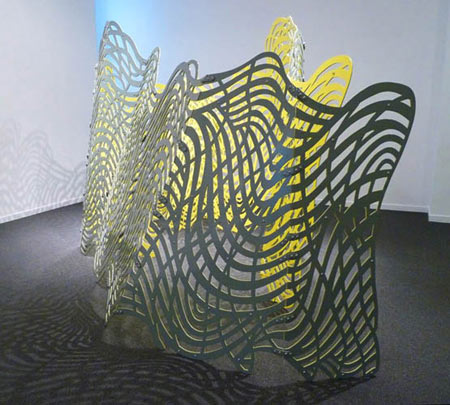
Continuing through April 30, 2011
In his blood-and-thunder fantasy, “The Narrative of Arthur Gordon Pym of Nantucket,” Edgar Allan Poe describes the strange properties of an unknown island’s fresh water: “It was not colorless, nor was it of any one uniform color — presenting to the eye, as it flowed, every possible shade of purple, like the hues of a changeable silk ... the whole mass of liquid [collected in a basin] was made up of a number of distinct veins, each of a distinct hue; ... these veins did not commingle, and ... their cohesion was ... Imperfect ... Upon passing the blade of a knife athwart the veins, the water closed over it immediately, all traces of the passage of the knife ... instantly obliterated. If, however, the blade was passed down accurately between the two veins, a perfect separation was effected, which the power of cohesion did not immediately rectify.”
Veined, semi-gelatinous water was probably not the inspiration for Linda Fleming’s wall and floor sculptures in “Meandering,” each crafted from very tangible, predictable steel and plywood, but the paradox of geometry enlivened by nature (or nature organized by geometry) in the same object imbues them with mystery and magic. The old theme of the contrast between architecture and surrounding landscape, between culture and nature, is here compressed into single entities: billowing lattices of steel that are flat and wall-mounted (“Loopy, Puff, Ping”), and a larger free-standing piece, “Storm,” almost an installation that invites the viewer inside, like some benign flower.
That merging of the organic and the geometric suggests Eva Hesse, whose studio contents — experiments and unfinished pieces — are on display currently at the Berkeley Art Museum. Fleming, born in 1945, is of the same generation, but she favors, instead of Hesse’s absurdity and pathos, the clean, refined, industrial look of modernist geometric abstraction — tossed by wind or water, then frozen. With their billowing lattices and meridians, these floating grids (or dancing musical staves) call to mind the fiber arts; but transposed into laser-cut steel that is powder coated or chromed, or painted plywood, they become monuments to flux and metamorphosis, as well as vehicles for enhancing perceptual awareness. They’re Minimalism or Post-Minimalism with a good dance beat.
The lustrously chromed wall pieces are lyrical drawings with spatial illusion generated by varying line widths. They also carry your gaze beyond the rippled surface of a lake into its depths. “Storm” contains those ambiguities as well. Its hinged panels open invitingly and its silver and yellow partners, laser-cut mirror-image duplicates, are perfectly aligned, reading as an object and its rhyming reflection or shadow. Fleming’s statements reveal the metaphysical aspects of her artistic meandering: she seeks to provide “a glimpse of the strangeness beyond the everyday world, opening a place where thought becomes tangible, history leaves a trace, and information exhales form.” It’s a journey to a place worth visiting.
Brian Gross Fine Art
